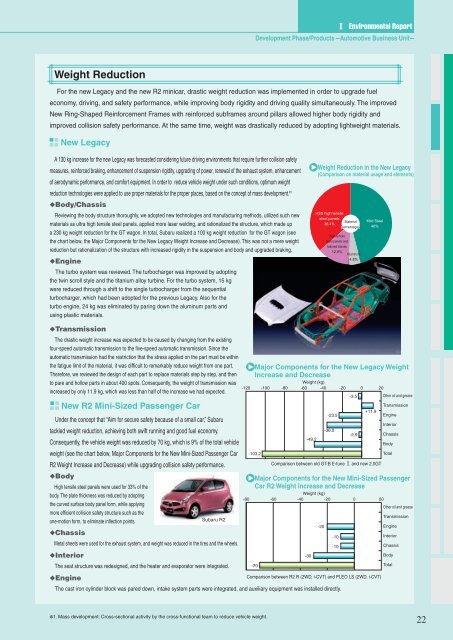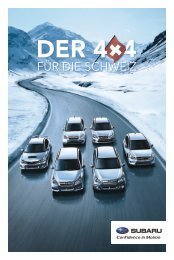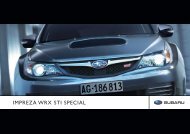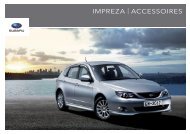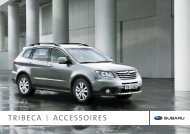Environmental & Social Report - Subaru
Environmental & Social Report - Subaru
Environmental & Social Report - Subaru
You also want an ePaper? Increase the reach of your titles
YUMPU automatically turns print PDFs into web optimized ePapers that Google loves.
1 <strong>Environmental</strong> <strong>Report</strong><br />
Development Phase/Products-Automotive Business Unit-<br />
Weight Reduction<br />
For the new Legacy and the new R2 minicar, drastic weight reduction was implemented in order to upgrade fuel<br />
economy, driving, and safety performance, while improving body rigidity and driving quality simultaneously. The improved<br />
New Ring-Shaped Reinforcement Frames with reinforced subframes around pillars allowed higher body rigidity and<br />
improved collision safety performance. At the same time, weight was drastically reduced by adopting lightweight materials.<br />
New Legacy<br />
A 130 kg increase for the new Legacy was forecasted considering future driving environments that require further collision safety<br />
measures, reinforced braking, enhancement of suspension rigidity, upgrading of power, renewal of the exhaust system, enhancement<br />
of aerodynamic performance, and comfort equipment. In order to reduce vehicle weight under such conditions, optimum weight<br />
reduction technologies were applied to use proper materials for the proper places, based on the concept of mass development. ✽1<br />
◆Body/Chassis<br />
Reviewing the body structure thoroughly, we adopted new technologies and manufacturing methods, utilized such new<br />
materials as ultra high tensile steel panels, applied more laser welding, and rationalized the structure, which made up<br />
a 230 kg weight reduction for the GT wagon. In total, <strong>Subaru</strong> realized a 100 kg weight reduction for the GT wagon (see<br />
the chart below, the Major Components for the New Legacy Weight Increase and Decrease). This was not a mere weight<br />
reduction but rationalization of the structure with increased rigidity in the suspension and body and upgraded braking.<br />
◆Engine<br />
The turbo system was reviewed. The turbocharger was improved by adopting<br />
the twin scroll style and the titanium alloy turbine. For the turbo system, 15 kg<br />
were reduced through a shift to the single turbocharger from the sequential<br />
turbocharger, which had been adopted for the previous Legacy. Also for the<br />
turbo engine, 24 kg was eliminated by paring down the aluminum parts and<br />
using plastic materials.<br />
Weight Reduction in the New Legacy<br />
(Comparison on material usage and elements)<br />
HSS high tensile<br />
steel panels<br />
Material<br />
36.4%<br />
percentages<br />
High tensile<br />
steel panels and<br />
tailored blanks<br />
12.8%<br />
Aluminum<br />
4.8%<br />
Mild Steel<br />
46%<br />
◆Transmission<br />
The drastic weight increase was expected to be caused by changing from the existing<br />
four-speed automatic transmission to the fi ve-speed automatic transmission. Since the<br />
automatic transmission had the restriction that the stress applied on the part must be within<br />
the fatigue limit of the material, it was diffi cult to remarkably reduce weight from one part.<br />
Therefore, we reviewed the design of each part to replace materials step by step, and then<br />
to pare and hollow parts in about 400 spots. Consequently, the weight of transmission was<br />
increased by only 11.9 kg, which was less than half of the increase we had expected.<br />
New R2 Mini-Sized Passenger Car<br />
Under the concept that “Aim for secure safety because of a small car,” <strong>Subaru</strong><br />
tackled weight reduction, achieving both swift running and good fuel economy.<br />
Consequently, the vehicle weight was reduced by 70 kg, which is 9% of the total vehicle<br />
weight (see the chart below, Major Components for the New Mini-Sized Passenger Car<br />
R2 Weight Increase and Decrease) while upgrading collision safety performance.<br />
◆Body<br />
High tensile steel panels were used for 33% of the<br />
body. The plate thickness was reduced by adopting<br />
the curved surface body panel form, while applying<br />
more effi cient collision safety structure such as the<br />
one-motion form, to eliminate infl ection points.<br />
◆Chassis<br />
Metal sheets were used for the exhaust system, and weight was reduced in the tires and the wheels.<br />
◆Interior<br />
The seat structure was redesigned, and the heater and evaporator were integrated.<br />
◆Engine<br />
<strong>Subaru</strong> R2<br />
Major Components for the New Legacy Weight<br />
Increase and Decrease<br />
Weight (kg)<br />
-120 -100 -80 -60 -40<br />
-103.2<br />
-49.2<br />
-23.5<br />
-36.0<br />
-20 0 20<br />
-3.5<br />
Other oil and grease<br />
-2.9<br />
+11.9<br />
Weight (kg)<br />
-80 -60 -40 -20 0 20<br />
The cast iron cylinder block was pared down, intake system parts were integrated, and auxiliary equipment was installed directly.<br />
-70<br />
Comparison between old GT-B E-tune 2 and new 2.0GT<br />
-30<br />
-20<br />
-10<br />
-10<br />
Transmission<br />
Engine<br />
Interior<br />
Chassis<br />
Body<br />
Total<br />
Major Components for the New Mini-Sized Passenger<br />
Car R2 Weight Increase and Decrease<br />
Comparison between R2 R (2WD, i-CVT) and PLEO LS (2WD, i-CVT)<br />
Other oil and grease<br />
Transmission<br />
Engine<br />
Interior<br />
Chassis<br />
Body<br />
Total<br />
✽1. Mass development: Cross-sectional activity by the cross-functional team to reduce vehicle weight.


